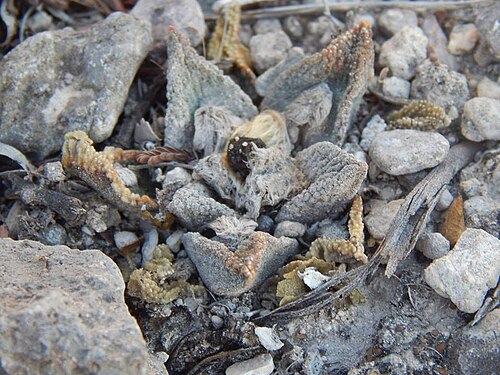Ariocarpus bravoanus
| Ariocarpus bravoanus | |
|---|---|

| |
| Scientific classification | |
| Kingdom: | Plantae |
| Clade: | Tracheophytes |
| Clade: | Angiosperms |
| Clade: | Eudicots |
| Order: | Caryophyllales |
| Family: | Cactaceae |
| Subfamily: | Cactoideae |
| Genus: | Ariocarpus |
| Species: | A. bravoanus
|
| Binomial name | |
| Ariocarpus bravoanus H.M.Hern. & E.F.Anderson
| |
| Synonyms | |
| |
Ariocarpus bravoanus is a species of cactus which is endemic to San Luis Potosí in Mexico. It grows in dry shrubland habitat on limestone substrates. It is endangered due to overcollecting.[1]
Description[edit]
Ariocarpus bravoanus is a fleshy plant grows geophytically with gray-green bodies that are 3 to 9 cm (1.2 to 3.5 in) in diameter and that barely protrude from the soil surface. The flattened, triangular and somewhat pointed warts protrude only slightly from the base of the shoot. The variable areoles sometimes have a woolly furrow along the entire length of the mastoid or are formed as a woolly cushion near the tip of the mastoid.
The magenta-colored flowers reach a diameter of 2.5 to 5 cm (0.98 to 1.97 in). The mostly light brown fruits are inconspicuous.[3]
Subspecies[edit]
As of 2023[update], Plants of the World Online accepted two varieties:[4]
Distribution[edit]
Ariocarpus bravoanus is found growing on xerophytic shrubland on a limestone gravel plains in the Mexican state of San Luis Potosí at elevations between 1500 to 2000 meters. and is only known from a few localities. The habitat is fragmented.[5]
-
Plant of Ariocarpus bravoanus subsp. bravoanus growing in habitat near Núñez, San Luis Potosi
Taxonomy[edit]
The first description was made in 1992 by Héctor Manuel Hernández and Edward Frederick Anderson.The plant was discovered while removing soil for the collection of another herbarium specimen.[5] The specific epithet "bravoanus" honors the Mexican botanist and cactus collector Helia Bravo Hollis. Nomenclature synonyms are Ariocarpus kotschoubeyanus subsp. bravoanus (H.M.Hern. & E.F.Anderson) Halda (1998) and Ariocarpus fissuratus subsp. bravoanus (H.M.Hern. & E.F.Anderson) Lüthy (1999).
References[edit]
- ^ a b Sotomayor, M.; Fitz Maurice, B.; Gómez-Hinostrosa, C.; Fitz Maurice, W.A.; Smith, M.; Hernández, H.M. (2013). "Ariocarpus bravoanus". IUCN Red List of Threatened Species. 2013: e.T40957A2947027. doi:10.2305/IUCN.UK.2013-1.RLTS.T40957A2947027.en. Retrieved 16 November 2021.
- ^ "Appendices | CITES". cites.org. Retrieved 2022-01-14.
- ^ Anderson, Edward F.; Eggli, Urs (2005). Das grosse Kakteen-Lexikon (in German). Stuttgart (Hohenheim): Ulmer. p. 72. ISBN 3-8001-4573-1.
- ^ "Ariocarpus bravoanus H.M.Hern. & E.F.Anderson". Plants of the World Online. Retrieved 2023-10-22.
- ^ a b "Ariocarpus bravoanus". LLIFLE. 2013-08-04. Retrieved 2024-06-15.
External links[edit]
 Media related to Ariocarpus bravoanus at Wikimedia Commons
Media related to Ariocarpus bravoanus at Wikimedia Commons Data related to Ariocarpus bravoanus at Wikispecies
Data related to Ariocarpus bravoanus at Wikispecies




